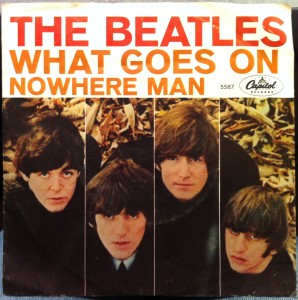
John Lennon’s trip into his consciousness works better as studio recording than live performance due to the songs vocal harmonic complexity and layered instrumentals.

“Nowhere Man” from The Beatles “Rubber Soul” album is clearly a studio song that did not translate well in live performance.
By the time the album was recorded in 1965, The Beatles were using multi-track recording to create music that was impossible to re-create on stage.
It’s no wonder The Beatles began to dislike touring. They couldn’t get their music across the way it was recorded.
Nowhere Man
Rolling Stone, the magazine of lists, says “Nowhere Man is #66 of the top 100 Beatles songs. “One of the pivotal songs of Lennon’s early Beatle years arrived when he least expected it. “The whole thing came out in one gulp,” he told Rolling Stone in 1970. “I remember I was just going through this paranoia trying to write something and nothing would come out, so I just lay down and tried not to write and then this came out.” What emerged was an expression of the boredom and frustration Lennon was feeling in his cocoonlike existence as a Beatle. The references to a man who’s “making all his nowhere plans for nobody” and “knows not where he’s going to” were, Lennon admitted, “probably about myself.”
The Beatles “Nowhere Man” remastered studio version with video montage
The Beatles were pushing George Martin, their producer, to experiment with new recording techniques in the studio. In his book, “All You Need Is Ears: The inside personal story of the genius who created The Beatles”, Martin said the studio at EMI Abbey Road was still pretty crude so they improvised by recording on the four-track tape recorder, mixing down to two tracks, adding more tracks, and mixing down again until the final mix.
Mistakes had to be fixed before the mix-down since they became embedded and their was little time in the 4 week “Rubber Soul” recording session to re-do whole mixes. The song was mixed in stereo but the best mix was always considered the mono. Few people buying rock records in the 1960s cared about left and right channel stereo.
Today, performers can create loops and background tracks that add studio-level complexity to their live performances.
Listen to the BBC TV recording which never quite gets the harmony right.
The intro John gives to the studio audience is priceless though.
“Nowhere Man” remastered studio version with video montage
The television performance is typical of The Beatles. The rhythm guitar descends into that VOX clangy sound with John’s raw strumming. Did you miss the sweet guitar harmonic note found 1:04 on the recording?
George Harrison’s lead guitar is lost in the mix and you barely hear the signature lead lick introduced at 19 and 29 seconds in the studio version. The recording fills out John’s singing with double tracking his voice. If you listen carefully you can detect different takes of the lead vocal merged together.
The problem with the song live is that the melody is pretty weak but the vocal arrangements in the studio were perfected with overdubs. We remember John’s strong vocal, the backup do-wop and unique harmony. Most of that is gone in the live performances. On the BBC video, the vocals are flat. Argh!
If The Beatles were performing today, they would have vocal effects like pitch correction, voice doubling, phase shifting, personal reverb and Fx in the live performances as well, with gear from TC Electronics and one or more vocal sound engineers off stage. Nothing is left to chance these days when audiences expect the live performance to duplicate the record.
The Munich 1966 performance is slightly better than the BBC taping but the same problems occur. The vocals are better but you have to wonder if Lennon was really that bad a rhythm guitarist. Lennon sounds brittle and clangy strumming. Where’s the signature high harmonic note?
The Beatles – “Nowhere Man” – Live in Munich 1966
Of course, who cared back then? If you were lucky enough to see The Beatles live that was all you needed.

Be the first to comment